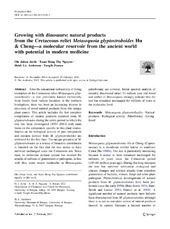Growing with dinosaurs: natural products from the Cretaceous relict Metasequoia glyptostroboides Hu & Cheng - a molecular reservoir from the ancient world with potential in modern medicine
Peer reviewed, Journal article
Published version

Åpne
Permanent lenke
https://hdl.handle.net/1956/10822Utgivelsesdato
2015-02-22Metadata
Vis full innførselSamlinger
Originalversjon
https://doi.org/10.1007/s11101-015-9395-3Sammendrag
After the sensational rediscovery of living exemplars of the Cretaceous relict Metasequoia glyptostroboides—a tree previously known exclusively from fossils from various locations in the northern hemisphere, there has been an increasing interest in discovery of novel natural products from this unique plant source. This article includes the first complete compilation of natural products reported from M. glyptostroboides during the entire period in which the tree has been investigated (1954–2014) with main focus on the compounds specific to this plant source. Studies on the biological activity of pure compounds and extracts derived from M. glyptostroboides are reviewed for the first time. The unique potential of M. glyptostroboides as a source of bioactive constituents is founded on the fact that the tree seems to have survived unchanged since the Cretaceous era. Since then, its molecular defense system has resisted the attacks of millions of generations of pathogens. In line with this, some recent landmarks in Metasequoia paleobotany are covered. Initial spectral analysis of recently discovered intact 53 million year old wood and amber of Metasequoia strongly indicate that the tree has remained unchanged for millions of years at the molecular level.
